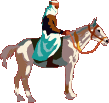|


      
|
Interview
with Roger Mimo: Leo the Andalusian
When
I first began the study of Leo Africanus, I was immediately drawn to
the obvious ambiguity of his 'identity' - born in the last enclave of
Muslim Spain, raised in the Maghreb, lived in Renaissance Italy. All
these different sojourns were bound to influence his notion of self
and identity. And so they did, as we see in his writing style, in his
attempts to shine an Italian light on Arab traditions, in his occasional
harsh judgments on Arabs or Berbers, or his unequivocal embracement
of certain of their ways.
This
ambiguity inherent to his history, personality and writing style was
greatly exploited by scholars on both sides of the Mediterranean. On
the one hand, Italians and European alike herald his escape from Muslim
lands and conversion to Catholicism as the necessary condition for him
to have written his great work, on the other hand, scholars from Morocco
stress the very 'Arab and Muslim' nature of his writings, refer to him
only by his original name (Hassan el Wazzan) and assert that his work
owes very little to his sojourn in Europe. The controversy is interesting,
certainly indicative of the very legitimate ambiguity of Leo's identity
and more so indicative of the growing importance of a historical figure
that different nations are trying to claim for themselves, each building
their own Leo Africanus or Hassan El Wazzan myth.
Until
I met Roger Mimo, I did not know there was a third party in the battle
to claim Leo! According to this charming, well versed owner of a beautiful
hotel in Tinerir, near the Todra Gorges, Leo was ANDALUSIAN, and certainly
not Moroccan or Christian European. What do you expect from a Spanish
man!
Roger
Mimo owns a small hotel in Tinerhir. He reconverted a splendid
Kasbah into a 20 or so room hotel, each tastefully decorated with
local colors and each interestingly named after one of the stages
of the Caravan Route that linked the Maghreb to the Bilal al Sudan
(literally, land of the Blacks). Marrakech, Oualata, Timbuktu,
Gao, Koumi Sale- every room has its little story about the activities
and trades one could encounter in each of these places. Perchance,
I happened to stay in his hotel during my own Caravan travels
(see Expeditions)
and was eager to strike a conversation on the topic. As it happens,
Roger had crossed the Sahara desert, along many of these caravan
routes a few decades ago, in a 4 by 4. The road from Morocco to
Mali is a dangerous one, crossing parts of Algeria and all of
Mauritania. But Roger Mimo doesn't seem like the type of person
to give up on anything!
Why did you name each of these rooms after a stage in the Caravan
Route?
When I started this hotel, I had just returned from my trip across
Mauritania where I had done quite a bit of reading about the Caravan
routes. I thought it would be a good addition to the hotel.
What do you know about Sijilmassa- I walked through the ruins
and was dreadfully disappointed by the lack of explanation or
anything there?
Very little has been written or said about Sijilmassa. As I live
in Morocco I have tried to read all the history books on this
region, and to my knowledge there isn't much. The best Description
of the city is in Al Bakri's work (XIth century geographer). By
Leo's days, the city was already in shambles. A few years back
there was an American/Moroccan cosponsored archeological dig,
and for sure they wrote something about their results, but I was
unable to find these. Also, I heard there was once a Museum in
Rissani, but when I went there to visit it, I was told that it
was closed. Who knows what they had in there!
Salt was one of the main goods transported across the Sahara
from North to South. I know about the great Salt mines in Northern
Mauritania. Do you know if there were any salt mines in Morocco?
I don't think salt was mined in Morocco. The land is very
salty, actually just a few miles from here, North of Ouarzazate,
there is a river called "Assif Mellah"- the Salty River.
But I don't think they gathered Salt in Morocco. No, Caravans
loaded fine crafts, dates and grains in Morocco, which they then
traded for Salt in Mauritania.
In reading Leo, I am always stricken by the very 'un-Moroccan'
nature of his prose. I don't think he would have been able to
write such a work had he stayed in Morocco.
For sure, he needed to leave his country before he could truly
reflect upon it. But remember that he was not Moroccan, he was
Andalusian. At the time, the Andalus were more refined culturally
and intellectually than any Moroccan or even Christian European.
We owe a lot to their culture.
In other ways, Leo's prose is actually quite Arabic or local.
For example, in each of the regions he describes, he always lists
the number of villages, then the number of 'chateaux' (castles).
This distinction is odd, given the meaning of Castle for Italians-
and there were certainly not that many single family, noble dwellings
in Morocco. Having lived here for many years now I realize what
he meant by this term. Castle, is Ksar, or fortified village-
the wall enclosed towns you see all across Morocco. Village, on
the other hand is Douar- a grouping of houses or tents. |
|